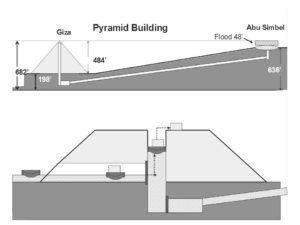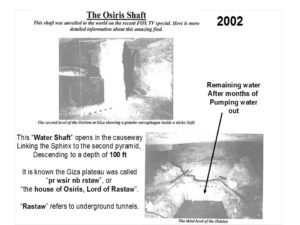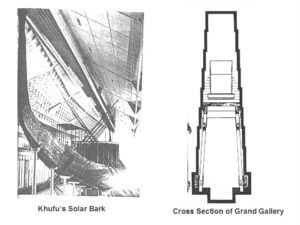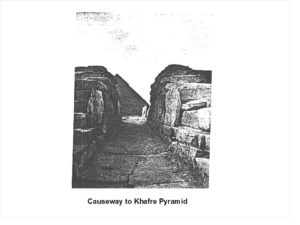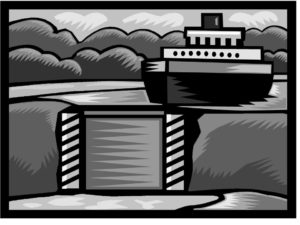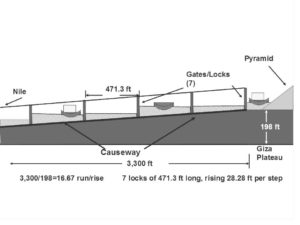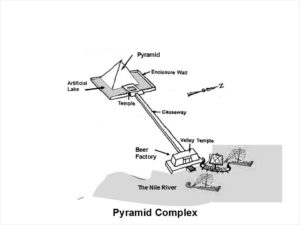How was the Great Pyramid Built?
(This chapter is taken from my book starting at page 34 of its first publication in 2003 and page 44 in 2014)
When I visited Egypt in 1989 and toured the Valley Temple next to the Sphinx, I noticed that there was a rectangular hole in the temples stone floor. Inside this hole surrounded by a fence was a pipe. I asked some of the caretakers of the monument what was this pipe doing there? They said that it was attached to water. I asked them whether the water was here at the Nile about two miles from Giza? They said, “No. Aswan.”
Aswan? How could there be a tunnel connecting water all the way up to Aswan, that was 428 miles upstream? Why bring water all the way down from Aswan to within 2 miles of the Nile at Cairo? Remember from my physical geology book that water trapped underground beneath impervious material would seek its original level if you cut a hole through that material? Think of these tunnels from Aswan down to the Giza plateau as a long giant water hose.
It may be helpful for the reader to go back to the section where I describe “artesian wells” or do a little experiment to understand the concept of my “water elevator”. Get you a water hose and attach it at one end to a container of water that is sitting on the ground. Leave the other end of the hose open but hold it above the height of the container. Notice that the water does not flow out of the container. Now either lift the container off of the ground to a position higher than the open end of the water hose, or lower the hose to where its open end is lower than the bottom of the container. Water will now flow out of the container and out of the hose. The higher that you lift the container of water, the faster will the water flow out of the hose. The increased difference between the vertical height of the container and the open end of the hose increases what is called the hydrostatic head. This hydrostatic head is the force produced by gravity acting on the trapped water in the hose. This pressure is caused by water trying to reach the level of the container while being constrained by the hose.
Now we can apply this same principal on a larger scale in relation to the height of the Nile River upstream from the Giza plateau. Aswan lies 465 feet above sea level, while Giza is 198 feet above sea level. The fall from Aswan to Giza is 267 feet. Therefore, because of the hydrostatic head or pressure produced by this drop in altitude and no way for the water to escape, you would be able to fill a hollow tube or tower full of water at the Giza Plateau up to 267 feet above the level of the plateau.
Now suppose that you had a valve to close off the water going to this tower and then placed a barge on the surface of the water. If you then opened up the valve, the water under pressure caused by the hydrostatic head would float this barge up to the top of the tower. Now you would have objects placed in such a boat, say stones, at the top of this tower.
However, since the Great Pyramid with its pyramidion, if it had one, would have been 484 feet high, the fall from Aswan would not give us enough lift. We would have to go further upstream. At the extremity of present boarder of Egypt is the Great Temple at Abu Simbel. Historians have wondered why put such a large complex so far upstream, where virtually no one lives. The answer maybe that it is 636 feet above sea level, which would give it a 438 foot drop to Giza, allowing for a potential lifting potential due to the hydrostatic head of 438 feet. The pyramid was 484 feet high, so we are still 46 feet short. But we know that the Nile flood increased the height of the Nile by at least 28 cubits according to the writings of Herodotus. 28 royal cubits would be 48 feet. Therefore at flood season the lifting potential of our hydraulic elevator would be 48+438 or 486 feet, which would suffice for both the present height and the theoretical height once the capstone is found and placed. We think we have found this capstone. It is a man. This man is the Honorable Elijah Muhammad.
Floating stones to top of Pyramid
Exhibit 6
Of course to build a tower that was strong enough to hold that much water under pressure would force you to build it much wider at the bottom than at the top. Now, do you see the shape of a pyramid coming into shape? We now know that there are tunnels beneath the pyramids (this was confirmed in the 1930’s). Now all we need to look for is the hole in the middle of the pyramids. Of course this hole was probably filled in after the construction was completed. However, there should be some differences in the type of material or consistency of the materials between the side walls and the fill.
So in other words, the Kemetic engineers used a type of water elevator to lift huge stones. No wonder that the “sacred barge” played such a large role in the rituals, on the walls and even buried next to the pyramids. Another reason for the sacredness of these barges and boats probably goes back to the “real” story of Noah. But let me not get too far ahead of myself.
The method of construction that I have just described required that somewhere near the central core of the pyramid should be evidence of some type of shaft that was our water elevator. I wrote the above section of this chapter in March of 2003. On April 7, 2003 I was in the middle of trying to put down some plastic mulching for our watermelon production. Unfortunately, I was rained out of the field. It rained hard for the rest of the night, making it impossible for me to get back in the field. This type of thing often happens when farming. The farmer is a slave to nature’s callings.
Exhibit 7
Since I could not go to the fields, I decided to go to the library and study. I did not go to the card catalogue but just went into the stacks. I know that the historical books are in the 900’s, so I just went to this section and browsed. I ran into a book by Miroslav Verner called “The Pyramids: The Mystery, Culture, and Science of Egypt’s Great Monuments” written in 1997. This book documents the latest findings and theories about the pyramids including their construction. The hypotheses included the use of counter levers and balances which I had theorized in my first book “Amen: The Secret Waters of the Great Pyramid”. When I wrote this book I had not seen any examples of my theories in any books previous to mine. However, in Verner’s book I saw diagrams that looked exactly like those from my book. However, I was given no credit, nor was my book referenced, which is par for the course.
In my first book I had suspected some type of hydraulic system, but I did not have enough material to come to a conclusion on the specific nature of the mechanism. Since I did not mention it, they could not steal it. However, this time I have presented the full blown theory and I expect for them to steal it as soon as possible.
After Miroslav Verner goes over the different theories of construction, he seems to be inclined to the ramp theories of Lepsius and Borchart as the more likely method of constructing for the majority of the fill for the Great Pyramid. However, only recently have they used a technology that could detect what was hidden deep in the interior of the structure. He states:
“Recently conducted investigations made by French geophysicists have shown, however, that the structure of the core is extremely heterogeneous. It probably also contains compartments filled with sand. This would be not only an economical but also a very sensible method.
The irregular compartments, which may also have been filled with small rubble and other waste material from the construction site, and whose dimensions and arrangement within the pyramid core cannot at this point be precisely determined, diverted the pressure inside the pyramid more effectively than did solid masonry. This must have been helpful during the occasional earthquakes that occur in Egypt.
The outside walls of the core, in contrast, consist of huge blocks laid in horizontal rows. Today, only 203 blocks remain – the upper seven rows seem to have been broken off. The height of the blocks varies between about one and one and a half meters. As in the case of the earlier Red Pyramid, the slightly concave walls were intended to increase the stability of the pyramid’s mantle.” (p. 195)
(I think that Verner meant 203 rows or courses of blocks, not just “203 blocks”.)
So what the recent discoveries of the interior of the Great Pyramid have brought to light is that parts of the core of the pyramid was filled with sand, small stones and rubble surrounded by larger and heavier stones. This is exactly the type of internal structuring that would be consistent with my theory of construction using a central water shaft as a type of elevator. After the pyramid was almost completed, they then would fill the shaft up from the top by dumping material that could be easily hauled up to the summit of the pyramid using ropes and pulleys.
If I were white, just this theory of how the pyramids were built using hydraulics would be enough for me to be a hero and be invited as a guest on major talk shows. However, because I am Black, I can be assured that my ideas will be stolen. However, it is important for you, the reader, to know that a Black mind invented the process, built the pyramids then passed on the knowledge around the mind of the “Colored Man” to reach the mind of a black once slave of this same “Colored Man”. Furthermore this same “Colored Man” must be given credit for mistakenly making available to this Black mind the material needed to find out what his grafted mind had missed. All Praises are due to Allah.
Another clue, as to this internal water shaft idea as being the right one, is that the Kemetic people were meticulous observers of nature. I remember that back in FOI class in Winston-Salem in the early 70’s the Honorable Elijah Muhammad instructed us to look at a movie about the ants. We wondered at that time why would we have to look at a movie about ants? Now at least one aspect about ants I can see as very significant to our present analysis.
Ants build structures that resemble pyramids. They look more like cones or small mountains instead of pyramids. However one can see where the Kemetic people got their concept of construction from. Ants are building their homes deep into the earth and excrete these pyramidal like structures in the process of tunneling through the earth. Each ant would carry a piece of earth up through the central opening of the mound and dump it out to roll down the sides. If so-called white people had taken the time and been humble enough to observe nature, they may have figured this thing out for themselves. Humility can be a great asset when confronting Allah’s creation, and the minds of those who are in line with the Creator.
Of Boats and Stones
By April 11, 2003 it was still extremely wet outside, so I could not go to the fields. In farming timing is everything and I was feeling a lot of frustration as I sat there helplessly waiting for Mother Nature to give me an opportunity to catch up. Since I could not do my farm work, I decided to go over this manuscript again. At least I could be doing something useful while waiting.
This whole construction thing was nagging at me, so I just decided to browse through some of my books. I glanced over a book that I had read many times, Edwards’ “The Pyramids of Egypt”. However, this time a passage struck me that I had read before, but now it took on a new meaning. Next to the Great Pyramid and other pyramids are boat pits. The theory is that these pits contained boats that were allegorical barges that carried the deceased King up the causeway to his final resting place in the pyramids.
According to Edwards one of these boats had been excavated and put back together: “The result of his work is a boat in almost perfect condition, 143 feet long (40 feet longer than the top of the pit), which is estimated to have a displacement of about 40 tons.” (p. 113)
Exhibit 8
Of course one would have to put this boat on water to determine its actual displacement and payload capacity, but 40 tons is close enough for my ancestors to give me the message. Thus far no one has discovered large rooms made of granite high up in other pyramids outside of Khufu’s, why? Khufu’s Kings Chamber is made of 100 granite blocks that are estimated as weighing 30 tons each. The five sets of blocks that make up what is called “relieving chambers” above the Kings Chamber are estimated to weigh 50 tons each. No one has figured out the use of these chambers nor why would they be made with such heavy stones. Any construction theories of pulleys or inclined ramps to move a stone weighing 100,000 pounds up to a level of 210 feet above the ground collapses under the magnitude of the physics.
These stones are reported to come from Syene near Aswan. The drop from Aswan to is 267 feet, quite a sufficient drop to raise these stones 210 feet.
However the boat’s length of 143 feet or 1716 inches is also a serious hint. The Grand Gallery in the Great Pyramid is over 1881 inches long from wall to wall. Its vaulted shape would seem to comfortably house such a boat. My ancestors had left the very instruments by which they had done this monumental work buried at the construction site, Khufu’s Solar Bark. This boat did not necessarily float within the Grand Gallery but in an elongated shaft within the pyramid just west of it which was filled in with sand and rubble after serving its purpose. The stones were floated from Aswan to their landing quay in the Great Pyramid, very efficiently.
The “water elevator shaft” would be the mechanism for pushing the stones upward within the pyramid to reach its final destination. However to convey the Tura limestone blocks and huge granite blocks up to the Giza plateau from the Nile required the utilization of the causeway that Herodotus described.
Exhibit 9
If we go back to his quotation, there are some dimensions of this causeway that are puzzling. He states, “This causeway is five furlongs in length, ten fathoms wide, and in height, at the highest part, eight fathoms.” A fathom is 6 ft and a furlong is 220 yards. Therefore this causeway was 1100 yards or 3300 feet which is over a half mile. Its width was 60 feet and was 48 feet high. Why would you need a road 60 feet wide and with walls 48 feet high just to drag some stones up? You don’t need high walls to drag stones unless these walls were somehow useful in the conveyance of the stones.
When I was in Egypt in 1989 as we traveled from Thebes up to Elephantine on a boat going up the Nile we had to past through at least two locks which lifted the boat over some rapids. Now Herodotus’ causeway makes sense if we add water.
As the water is lowered from our water elevator it would then flow out of the pyramid and down to the Nile via this causeway which had several gates or locks to control the flow of the water so that it could be used for lifting purposes.
Lock in a River
Exhibit 10
Exhibit 11
According to Herodotus’ figures of 3,300 feet total causeway length, a set of 7 locks of 471.3 ft each in length and 48 feet high would leave ample head and ballast room for a rise of 28.28 ft per lock. This would allow us to raise boats laden with stones from low Nile to the Giza Plateau. The causeway width of 60 feet would allow two boats per lock, one going up and one going down.
Once the pyramid was completed the underground tunnels were used to move the water from the well beneath the pyramid into the purifying chambers of the Great Pyramid. Then it could flow down this same causeway to waiting ships and other sets of tunnels taking water to the Delta region downstream. Again no work was wasted. Major construction works needed to build the pyramid was subsequently used once the pyramid was in use.
Exhibit 12
You can purchase the book at: http://noimoa.com/product/i-will-not-apologize-the-resurrection-of-the-master-architect/

